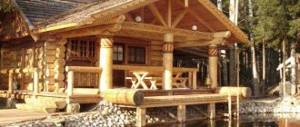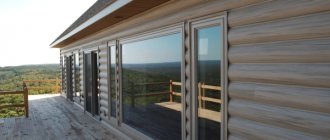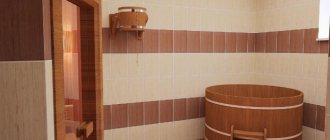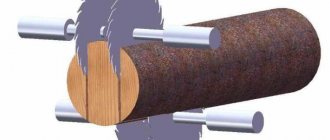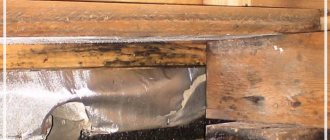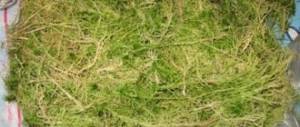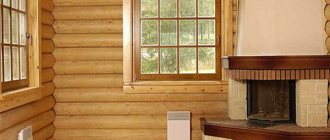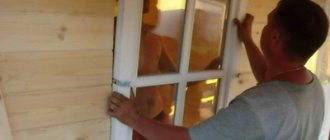I am glad to welcome my reader again!
Today we’ll talk about how to paint a log house? In general, I would say this: paint it a different color or preserve the original texture of the log house. Even if in some places with areas darkened by time and other external natural defects, but preserved in an authentic form. The topic is: how to paint the outside of a bathhouse frame and be satisfied with your work for many years?
Just in case, be mentally prepared for the fact that after painting you will not see exactly what you saw on the salesperson’s display board in the store. Somewhere the shade is not the same, roughness is possible, and the paint consumption, as a rule, exceeds what was promised. Let me reassure newcomers - this is a common reaction.
They paint ideally only in television advertisements... remember, they will run a brush or roller over the wall and immediately get a beautiful solid color. But this is the merit of the cameramen, not the paint manufacturers or plasterers. And in life, there are always “pleasant” nuances.
Why do you need to paint the outside of a wooden bathhouse?
- For protection against weather conditions. Sun, precipitation, wind - all this does not improve the tree;
- To protect against temperature changes emanating from inside the bath, which also affect the durability of the material;
- For protection from various biological lesions;
- For a more aesthetic appearance.
Points 1, 2 and 3 serve to extend the life of the wood base, and this is the main thing. And point 4, for some, is a controversial point. Someone will say, how can the color of paint be better than the texture of natural wood...
Painting of the log house must be preceded by the application of a primer coating, an antiseptic and a fire retardant compound (pyrine retardant). It is important. The antiseptic will create protection against wood insects, fungal mold, rotting and other things, antipyrine, and increase the fire resistance of the structure. Both substances can be chosen either in the form of a colorless substance or an enriched color.
By the way, there are some paints that contain antiseptic and water-repellent impregnations. According to many experts (who always play it safe), it is better to perform priming as a separate process.
And after sanding (when the wood loses its roughened layer and becomes easily accessible to all kinds of biological damage), this must be done immediately.
Before treating with protective substances, you need to check the quality of the log caulk and, if necessary, bring it into compliance. It is worth considering that the ends of the log house absorb moisture more strongly and therefore it is recommended to apply two or three additional layers to them.
The main stages of preparing a wooden structure for painting
The technology for painting the outside of a wooden house includes several stages. If you want the paint to lay smoothly and beautifully, so that the coating turns out to be of high quality and durable, you must strictly adhere to the technology and consistently carry out all the preparatory work.
- First, the logs are polished with a grinder using a coarse abrasive with a grain size of P 60-80. Small cracks, nicks and other defects that remain on the wood after sawing are removed from the surface.
- Next, the surface is polished. A fine-grained nozzle P 120 or regular sandpaper is suitable for this work, with the help of which the wood is brought smooth. As a result, the surface becomes smooth and completely ready for further processing. After sanding, the wood better absorbs impregnations and paints.
- Using a construction hair dryer, the walls of the house are cleaned of wood dust formed during the sanding process.
- If there are resin stains on the wood, they are removed with a solvent.
- If there are small cracks and knots that were not removed by sanding, these places are puttied with a special wood putty.
- All metal parts (screws, nail heads) are coated with a special primer for metal.
- Next, the surface is treated with a water- or oil-based antiseptic primer to protect the wood from the adverse effects of atmospheric and biological factors. After the primer has completely dried, begin painting the house.
How to prime the log house?
Of “our” “priming” products on the market, I would like to highlight Neomid. What distinguishes it is good quality and reasonable price. The line of products for wood allows you to “close” almost all needs: Fire protection, bio-antiseptic, moisture protection, etc. Reviews for the brand are good.
Another Russian manufacturer, the Senezh company, which produces a rich line of products. The assortment includes several protective compounds for different purposes (I mean, intended specifically for outdoor woodwork). In addition to primers, there are varnishes and paints on an organic and synthetic basis (acrylate, oil, etc.).
How to paint a log house Biocolor Aqua
The glaze composition is produced ready for use. The ambient temperature during painting should exceed + 5 degrees. The surface must be clean and dry, without the presence of fungi and mold (if any, you need to get rid of them and their traces using wood bleach). It is advisable to treat the log house with antiseptic compounds before applying paint.
Photo: as an antiseptic treatment, it is best to buy and apply Neomid impregnation products.
Tools can be used as desired (roller, brush, spray gun). It is allowed to dilute the paint with a small amount of water when applying it with a spray gun. You need to paint in several layers. Is a fireproof paint. The surface dries after 12 hours. During work, you need to be careful not to get the composition on the mucous membranes and skin.
Photo: Traditional paint brushes work well as a tool for impregnation and painting.
It is quite possible to return an old log house to a beautiful, presentable appearance. To do this, you just need to choose the right paint and paint the frame. When choosing, the main thing is to rely on the popularity of manufacturers and consumer recommendations.
How to paint a log house?
The lower crowns are treated with waste oil.
Let's divide the materials into two types: folk and modern. First, I will give a few folk recipes. What if someone wants...
Waste machine or transformer oil
Yes, the smell is not very good, but it will disappear after a while, but the impregnation will remain and will create a waterproof layer. Although dust sticks to it “freshly”. Apply the oil with a rough brush and rub in thoroughly.
Turpentine and wax
Mix in equal proportions. In addition to protecting against moisture, this composition provides good protection against wood insects and gives the walls of the log house a certain gloss of “well-kept antiquity.” Particularly suitable for painting baths “in years”.
Oak bark decoction
A nice darkened background, however, the wood pattern is clearly visible through it. An old and forgotten method.
It is better not to make coloring compositions from onion broth (these are not eggs for Easter). Yes, they give the logs a pleasant shade, but as an “undesirable bonus” they have a smell that attracts insects.
My opinion is that you shouldn’t get carried away with environmental products. In a number of ways, it is no longer easy for them to compete with the products of the chemical industry. But if you are a principled supporter of natural raw materials, then, without a doubt, go ahead!
What is better for processing
After identifying the cause of the problem, it is necessary to find ways to solve it. It is important to choose the right product to protect the ends of the timber so that they do not crack.
Sealant treatment
A wooden building will last longer if the end cuts are covered with a special sealant. It will seal existing cracks and prevent future cracking. After application and drying of the coating, a protective layer is formed on the surface.
The use of sealant does not require additional treatment of the wood with various antiseptics.
Thanks to the sealant, you can forget about cracks for a long time. It has the following effect:
- protects from excess moisture;
- reduces tension inside the log;
- Gently clogs pores while allowing the surface to “breathe.”
Dye
Another processing method is to coat the logs with paint.
The paint must be diluted with a solvent before application.
Using paint as an end putty:
- allows you to seal the timber, creating a surface protective layer;
- protects cuts from water and other external factors;
- ensures uniform evaporation of moisture;
- protects the surface from cracks.
Lime
Traditionally, lime was used to process saw cuts.
This natural antiseptic is distinguished by the fact that:
- disinfects the material and prevents the process of rotting;
- not afraid of UV radiation;
- has a relatively low cost.
However, this composition does not provide long-lasting protection and is quickly washed off by rain. The treatment will have to be repeated several times a year.
Experts advise using lime only for the first two years, and then using more reliable professional products.
Special processing agents
The modern construction market is filled with all kinds of coatings that protect wooden log houses well.
Biotor
Thanks to this solution, the deformation of the log is noticeably reduced.
The BIOTOR composition forms an elastic coating that is absorbed into the wood several centimeters, thanks to this:
- prevents the formation of rot;
- reduces the number of end cracks and their depth;
- helps remove excess moisture from wood;
- reduces wood deformation during drying.
Biotor retains its protective properties for a long time. This is a frost-resistant and fireproof material without solvents or odor.
After applying the antiseptic, the shade of the wood changes slightly, which allows you to control the untreated areas.
Neomid Thor Plus
The antiseptic creates an elastic, water-repellent coating with good vapor permeability, which allows the wood to “breathe.”
The coating has the following effects:
- protects wood from rotting;
- prevents the development and appearance of microorganisms;
- reduces linear deformation of timber during operation.
The resulting colorless film preserves the natural grain of the wood.
Senezh Tor
The product penetrates deeply into the wood and forms a reflective thick-layer elastic coating on the end surface, which normalizes the evaporation of excess moisture. In addition, this antiseptic:
- prevents cracking;
- protects against biological damage;
- does not affect the natural texture of the wood;
- provides reliable protection for several years.
The protective composition does not contain prohibited chemical compounds and is therefore safe for health.
Experts are against processing end cuts with the following folk remedies:
- machine oil;
- PVA glue;
- candle wax;
- varnish
They clog the pores of wood, disrupt air circulation and moisture exchange at the site of application.
Now I turn to modern materials
I will talk about those that are intended specifically for wooden buildings.
Belinka
The Belinka brand has long proven itself well. The range includes not only paints, but also varnishes, various impregnations, and glazing compounds. The range of shades of varnish and paint is very colorful, allowing you to preserve the texture of the wood, emphasizing it with a decorative background. Belinka polyacrylate paints create a film on the surface of wood that, on the one hand, has water-repellent properties and, on the other, is vapor-permeable.
Tex
Professionals speak positively about the Russian manufacturer Tex. In addition to paint, the company has several types of antiseptics, including ground and glaze, drying oils, fire retardant impregnations and wax-based compounds.
A separate point that is often not paid due attention: the protection of metal parts. Heads of nails and screws, hinges, corners, etc. are susceptible to corrosion. For protection, special compounds are used. The same Neomid has them.
Tikkurila
If finances allow, contact the Tikkurila brand, respected in Russia. The paints of this Finnish manufacturer have been tested in the harsh conditions of the northern climate. They contain components containing various additives that prevent the formation of rot, moisture absorption, and protect against ultraviolet radiation.
You can choose from acrylate paint called Pica-Techo, oil Techo, polyacrylate, Ultra-Classic. This brand, in addition to its relatively high price, has another drawback - names that are difficult to remember. Here they are.
And of course, the Finnish company has all EU certificates confirming environmental friendliness.
By the way, if the coating of the log house was done with oil paint, then the next coating (for example, after 3-5 years) should also be done with oil paint.
In general, recommendations for painting a log bathhouse boil down to what needs to be taken into account:
- Firstly: the better (that is, more famous) the manufacturer, the better and more durable its primer and topcoats;
- Secondly: use special-purpose compounds, in our case, intended for external wooden walls. If you find among well-known manufacturers special paints for facades made of rounded logs, it will be even better, but, unfortunately, I don’t know such paints.
Saikos
Finally, let’s touch on the German manufacturer SAICOS. The catchphrase - “True German quality” is very relevant to this day. The main feature of this product is that the base is only natural oils and waxes. The conclusions here are simple: such wood impregnation will preserve your structure for many, many years. In a word - I recommend it. I think that professionals will understand me...
The process of applying antiseptics and primers to sanded walls
After sanding the walls of the house, you need to treat them both inside and outside. The work is complex and requires material investments. Not everyone has the patience to finish it to the end.
Before applying the main layers, you should pay attention to the caulking of the log house walls. If cracks appear, re-caulk.
To seal cracks, special sealants are produced that cover the caulk and protect it from the harmful effects of the environment. If the caulking was made with natural flax fiber, then it is necessary to protect it from moisture. You can use, for example, Neomid or Remmins sealants. Only after complete caulking around the entire perimeter and its processing can you begin painting the walls.
End finishing
When processing the surface of the log house walls after grinding, you should pay special attention to the ends of the log or timber. Wood capillaries are located from top to bottom for better penetration of liquid to the crown. When sawing, these channels are exposed, and moisture from the environment easily enters them. If you treat the ends with a simple sealant or antiseptic, this will not bring the desired result. This means that over time the walls will crack and darken. Finnish manufacturers recommend using acrylic moisture-resistant product TEKNOL JRM. After such painting, the permeability of moisture into the ends is reduced by 15-20 times. This product costs from 350 rubles/3 liters.
Liquid glass treatment works in a similar way, but it contains toxic substances. But it is cheap.
Any of the selected products should be applied in two layers, carefully covering all joints. Before applying the second, the first is allowed to dry.
Wall treatment
The walls are treated in the warm season at above-zero temperatures, immediately after sanding and caulking, immediately after the construction of a house made of profiled timber is completed. Grinding is best done using a grinding tool with a P80 disc. After this, the dust is removed from the logs and the first layer of antiseptic is applied, for example colorless Teknol Aqua 1410-01. Painting should be done with a brush or electric spray gun. The primer is applied in two layers.
The next step is to process the walls again using a sanding machine with P220 or 240 discs. After applying the primer, hairiness appears, which is better to remove. Sanding will take a long time and requires expensive and powerful equipment. So a high-quality grinding machine costs from 2,000 rubles. And with high power, sanding a 30 cm wall takes about half an hour. Of course, you can skip this step, since it does not affect the protective characteristics.
The next step is painting with glazing compounds. You can use a covering antiseptic. The compositions must be applied in the same way, using a brush or spray bottle.
To save money, instead of glazing compounds, you can use simple acrylic paint for facades. But the wood texture will be hidden. For example, acrylic paint for Tikkuril facades tolerates temperature changes well and has many shades and colors. The cost of this product is from 1,500 per 10 liters.
With high-quality processing and caulking, wooden walls will serve the owners for more than 50 years. But painting should be done at least once every 3-4 years. It's nice to be in a wooden house that not only looks good, but also breathes. And this can be achieved only by painting the external walls after sanding with natural and high-quality materials.
Requirements for protective equipment
After the construction of a log house, it is necessary to carry out initial processing of the ends, taking into account wood shrinkage in the first year of operation of the house
The most important requirement is that the means for processing the ends should not interfere with the natural processes of shrinkage of the log house. Necessary characteristics of an antiseptic for the ends of a log house:
- The antiseptic should not prevent the evaporation of liquid from the logs through the longitudinal fibers of the ends.
- The antiseptic should not slow down the process of getting rid of moisture in the transverse fibers.
- The antiseptic should not interfere with the removal of moisture from the surface.
- The antiseptic must provide protection against UV rays.
- The antiseptic should prevent the wood from rotting.
Features of painting a log house
Considering the fact that the beauty of wood lies precisely in its texture, it is advisable to paint it with translucent paints and varnishes. Painting requires preliminary preparation, which includes the following:
- The first step is to choose a paint that matches the color of the seam sealant. Experienced specialists prepare 30% more paint.
- The tones of the walls can be different, so to avoid different colors, the log house is bleached with special compounds.
- Before you start painting, you need to use a compressor to blow out any remaining dust on the surface of the log house.
- It is necessary to strictly follow the painting technology; violation of it leads to peeling of the paint on the walls.
- When a log house is painted with brushes, double painting will be required, and painting with a spray gun is done up to four times.
- To paint a log house outside and inside the house, different paints are used.
- If the walls have not been sanded, then defects will be visible on them, and paint will not hide them, so it is necessary to sand the frame before painting.
Before you paint a wooden frame, you need to choose the color of the paint. It is applied to test boards, but you need to take into account that on the walls the shade will turn out different, since the area to be painted will be much larger.
Material selection
- harvested in winter, when it is lowest, due to the slowdown in the movement of juices (can be found in warehouses until May);
- dry in a chamber for at least two weeks before use;
- during natural drying, lasting more than 2 years, it should not be exposed to sunlight, for which a canopy is installed;
- be with a cross-section ≤ 200 mm (less susceptible to cracking).
Glued laminated timber, made from stringently selected and special materials. processing of boards, glued with alternating directions of wood fibers. This significantly increases their ability to resist cracking.


